Running a travel business is no joke. Well, you know, saying that the travel industry is highly competitive an understatement. Even the giants with over a hundred years under their belts can fail given bad luck and poor management.
Earlier this year, Thomas Cook, the British tour operator and one of the world’s oldest travel industry titans, disastrously imploded. By the time of the breakdown, the company had 19 million annual customers. Pretty impressive, right? In addition to major reasons like enormous debts and difficulties in operating airlines, its lack of online presence and a reduced demand for tour packages caused the company to go downhill. Without changing its business model and broadening distribution channels, Thomas Cook was destined to be overthrown by Booking Holdings and Expedia.


Marketing in Online Travel Agency
The market is extremely competitive, and it undergoes changes, becoming increasingly more digital. This calls for intricate approaches to marketing, distribution, and travel products themselves. Here, we will describe the distribution and communication channels, revenue management techniques, product positioning, and the technology – survival strategies all.
Understanding the travel agency market
Let’s talk about challenges first. In an industry with such a competitive nature, smaller travel agencies face three major hurdles.
- Leading players holding the market. Booking Holdings with its 41 percent share and Expedia with about 32 percent are dominating the online travel agencies market. And their shares keep growing. So, for travel agencies, it’s difficult to stay afloat without a specific niche.
- Distrust. People tend to be skeptical and even suspicious in arranging their trips. They would rather follow word of mouth, go to their old, time-tested local travel agent, or stick to larger players, even if they are not totally satisfied. So, new travel agencies have to work hard to break through the wall of mistrust.
- Invisibility. Unless a travel provider puts a lot of effort and resources into promotion, it risks staying unnoticed. Here, the choice of distribution channel plays a decisive role.
That said, midsize and small travel agencies narrow value propositions down to specific market segments, where you can become visible and win the trust of your small, but paying group of travelers. Unless you want to conquer the world and compete with Booking.com, Expedia and their owned brands, your profile of a travel agency is most likely to fit one or several of the following characteristics:
Destination-specific. You target a certain destination or a region where you can supply customers with the best deals or unique products (not available on Booking.com/Expedia, etc.). It doesn’t mean that smaller travel agencies are always location-limited. But, usually, there’s a handful of destinations that can keep the business running.
Price-oriented. Price has been one of the driving forces of travel purchases for years.
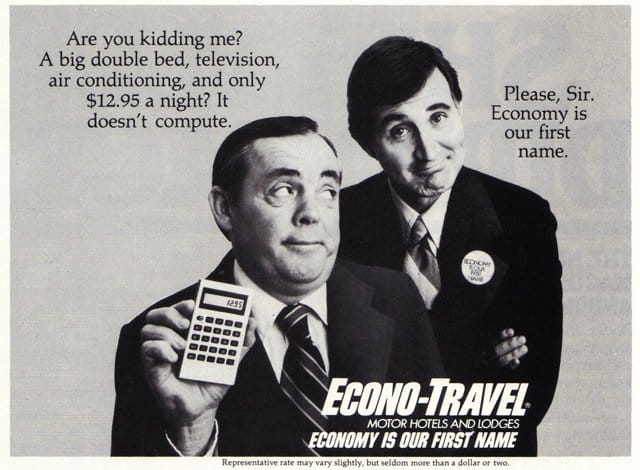
This ad, published in National Geographic by Econo-Travel hotels, dates back to 1978
Today, price remains one of the key considerations for travelers. Skift 2019 Research shows that almost 60 percent of travelers name lack of money as a factor that holds back travel decisions. This is partly confirmed by the changes that low-cost carriers bring to the table, as the destinations where LLCs start flying experience higher traveler inflow. For instance, in Krakow, Poland, the number of foreign tourists grew from 680 thousand in 2003 to 2.5 million in 2007 mostly due to the development of air travel and low-cost flights in particular. So, the basic scenario for most travel agencies is to compete by price, unless you specifically target luxury or business segments. Still, you must trump major OTAs in terms of pricing and in your target segment to survive.
Specific demographic. Another way to narrow down the focus of a travel agency is to work with selected regions, budget expectations, style of travel, age groups, family/single tours, etc.
The unique angle to user experience. Another way to stand out is to find new approaches to searching for and purchasing trips. While there are many online travel agencies that follow the beaten path of suggesting travelers choose destinations, dates, filter the results, and pick their travel product, numerous startups are exploring and reinventing travel booking experiences. Kiwi.com suggests a powerful engine to match non-interlined flights, create complex flight itineraries with multiple stops, and book them. Eightydays.me capitalizes on travel research fatigue, allowing travelers to define the date range of their trip and the number of cities they want to visit. The service will generate an itinerary itself, choose the cheaper options, and suggest booking.
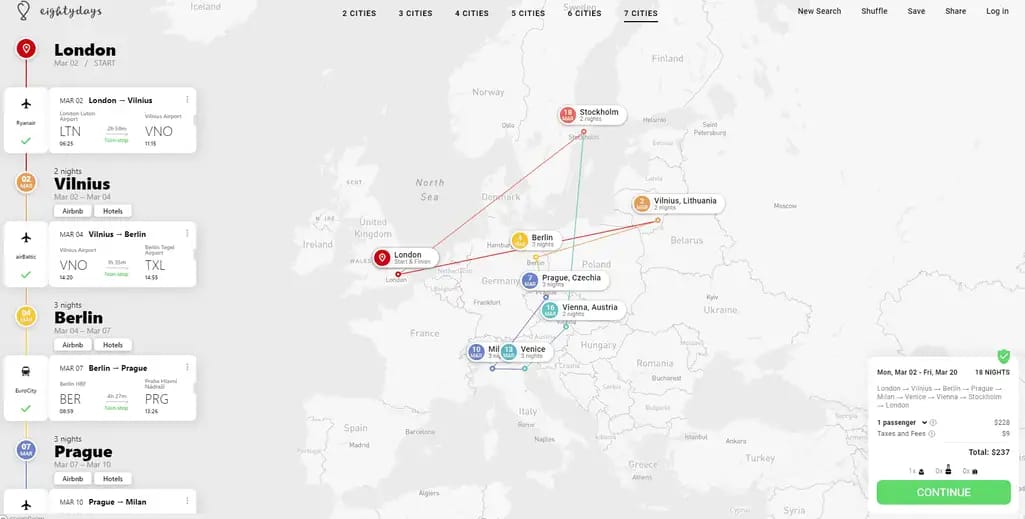
It will take days for a regular traveler to create such a complex itinerary, Eightydays cuts this to minutes
Basically, the high-level, strategic goals of modern travel agency marketing are clearly articulating a narrow segment that you address (lower prices in specific destinations, traveler region, demographics, etc.) and choosing the best tools to promote the service. So, let’s start with understanding customer segments.
Investigate and define your market and target audience
It’s likely that you already have an image of your dream traveler in mind. Or you may at least have a set of hypotheses that you must test. At this point, you want to clarify as many details as possible.
Who are your travelers? First, recognize who you are targeting and how users interact with similar products in terms of their gender, age, ethnicity, income, qualification, and marital status. For instance, there are big differences in the way different age groups travel and spend during their trips. There may be different motivations. While boomers are looking for ways to relax and unwind, millennials seek more adventurous and experiential travel.
Where do they go? Understanding traveler demographics will help you narrow down the number of strategic destinations and service providers that operate there.
How do they look for tours and tickets and how do they book? Hold preliminary research on users’ behavioral patterns. Find out what channels they use to find a ticket or a tour. These may include different search engines, metasearch engines such as Kayak, a local offline travel agency, or a tour operator. If you aren’t new to the industry, you’ve probably heard that people use on average 2-3 travel websites to book products and make 120 to 160 visits to travel websites in general. But try to map your specific user journey by running interviews or at least checking the info in open sources. This information will help you understand the main distribution channels.
How often do they travel? Exploring this question may give you some painful answers. While on average, say, Americans travel twice a year, your target group may be traveling so rarely that you can end up finding this segment is not viable.
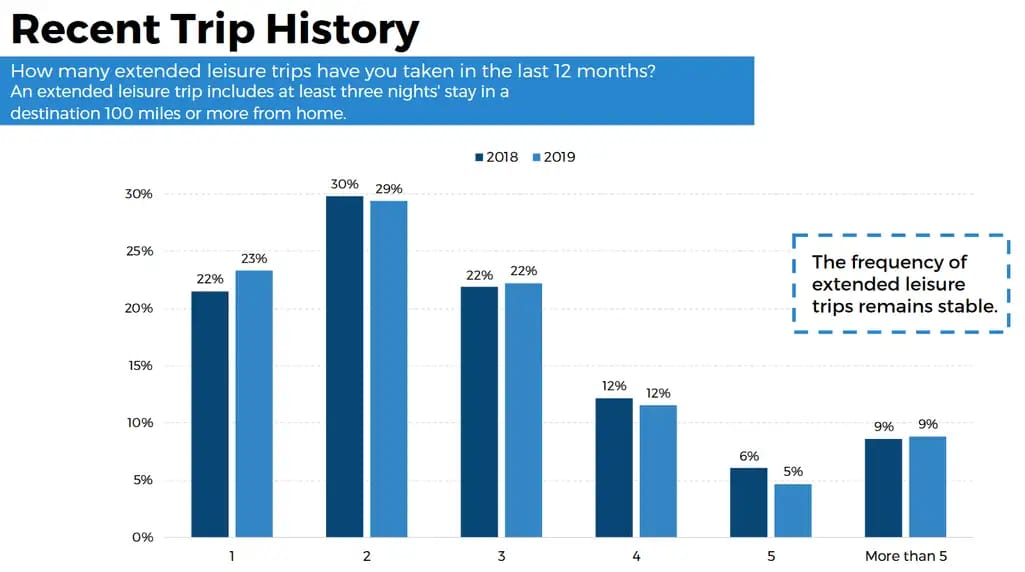
Skift, Experiential Traveler Survey, 2019
How price-sensitive are they? As we mentioned above, price sensitivity is an extremely powerful factor in travel. And sometimes, its strength looks absurd. Mark Trim, creator of a niche online travel agency in Australia that sells round-the-world flights, shares: “We have noticed people are extremely price-sensitive to their main airfares in this climate, they’ll make a decision on a $10-20k trip depending on a $100-400 fluctuation in their airfare costs which still strikes me as quite strange.” Most likely, even if you target luxury travel, you’ll find your audience price-sensitive as well.
But it’s still worth analyzing the expenses that your target group is ready to pay for a ticket or a tour. In addition to further pricing strategy, it will also give an understanding of price ranges.
At the end of this stage, you must have a clear portrait of your customers and their groups. We recommend creating user personas to document your findings and communicate them to your team. You may learn more about user personas in our article on UX research.
Analyze your competitors
Once you have an idea of your dream customers, it’s time to look at the ways they book trips with your competitors.
Which competitor products do they use? Analyzing the market is also about researching competitors-to-be. Examining products similar to yours that your audience uses helps pinpoint the areas of improvement and develop a positioning statement. After defining the main competitors-to-be, it’s time to research their strengths and weaknesses.
How do they win? Defining the good sides of products alike helps discover what components, characteristics, elements, and overall flow that are the most popular among users. We are not telling you to copy them, but this information can be extremely helpful to understanding user preferences.
How do they fail? Finding out the rivals’ vulnerabilities paves the right way to identifying the market gap and creating the service that would be employed by users. This is how you find product/market fit.
Run SWOT analysis. We’ve detailed SWOT analysis specifics in our product marketing article. Generally, this technique allows you to map your strengths, weaknesses, opportunities, and threats to prioritize the direction of further development and define how you stack up against competitors.
Establish your partnerships with service providers
Perhaps, the main assets of any travel agency are the negotiated rates and deals with end-product suppliers, airlines, hotels, tour operators, etc. While you can hook up your booking engine to global distribution systems (GDSs), connect with hotel suppliers, or tours and activities APIs, and call it a day, most midsize and small travel agencies exist because of their negotiated deals in a number of travel segments.
The thing is with generic offers that every other travel industry player has, your product won’t be competitive. Given that you know your target destinations, value, and price sets, you should narrow down the number of providers you try to develop relationships with. It doesn’t mean though that you can’t offer flights and listings that you haven’t negotiated at all. GDSs, for instance, will provide you with generic deals that you still can sell.
Eventually, you must have a pool of key suppliers ready to work with you on exclusive conditions.
Define your pricing strategy
When you have identified your target audience, found your segment, and have negotiated all your deals with providers, it’s time to think about the pricing. Obviously, marketing here overlaps the revenue model. Exploring different pricing strategies of travel agencies and diving into all the intricacies is way beyond the scope of this article. We’ll just outline the main directions of your further research.
Explore standard profit margins that your suppliers have. Different regions and different suppliers may have varying profit margins. But regardless of all factors, traditionally, they are low. Again, the competition in travel is fierce and unforgiving. You may expect to get higher returns at hotels and significantly lower ones for flights. Understanding at which profit margins your suppliers operate will help you define your commissions.
Find where your key suppliers distribute besides you. In a way, your suppliers are also your clients. And you have competition on the other end of the chain. You must understand the markup other travel agencies and online travel agencies have to specify your markup and balance competition with profitability.
Try setting bespoke markups for all your target suppliers. We’ve described how pricing rules work at online travel agencies. They can be as simple as setting a single markup figure for all your products, but what you really want to achieve is having varying markups for different travel products, depending on competition, demand, and commissions that you receive from each supplier.
Regardless of whether you have an automated booking engine, you operate mostly manually, or you have a hybrid of these two models, you must have a set of commission rules that navigate how you approach different suppliers, how you offer discounts, and how these things differ depending on distribution channels. Which is what we’re discussing next.
Determine the right distribution and promotion channels
Once you’ve shaped the strategy, it’s time to set up the distribution channels. Here are some of the best practices.
Metasearch engine
Partnering with large metasearch engines like TripAdvisor, Trivago, Kayak, or Skyscanner is arguably one of the most significant steps in making your service visible and stand out from large OTAs. Metasearch engines aggregate the deals from OTAs and supplier websites to allow travelers to compare them and choose where to book.
Metasearch creates a powerful distribution channel, especially if your core differentiation is price. Ultimately, people visit metasearch engines to get an idea of available deals and compare prices. Travel agencies, usually, get featured there, based on a pay-per-click model, similar to regular ads.
So, if you decide to distribute using metasearch engines, what should you keep in mind?
Investigate your competitors’ rates. First, you have to know the situation on the market, what deals are presented, and how you are being ranked compared to your competitors. On learning the performance of key products, you’ll understand which offers you should submit. Given that most travelers will be choosing based on pricing, the products in your target segment and by your target suppliers must be cheaper.
Use analytical tools. But how exactly are you going to check whether your deals compete well? Your competitors’ markups will be constantly changing. And your deals will change their positions as well. There must be some way to keep an eye on your performance and adjust markup to stay competitive. Many small travel agencies would manually check their segments. Another way here is to purchase the web analytic reports from some of the metasearch engines. In addition to automating all research efforts, it will also help you understand what the competition is and how your opponents rank. For instance, Skyscanner provides its Performance Analytics for Partners program.
Manage your markup. To reach your final goal and be visible in the search results, you can now manage your markup or promise unique deals. The level of automation here also depends on your resources:
- You can manually check prices and manually change markups.
- You can use automated dashboards to track your performance and then manually change markups.
- The most advanced scenario is to create an automated commission engine that will keep all your markup rules and will be adjusting your margin on the go, reacting to competitor results.
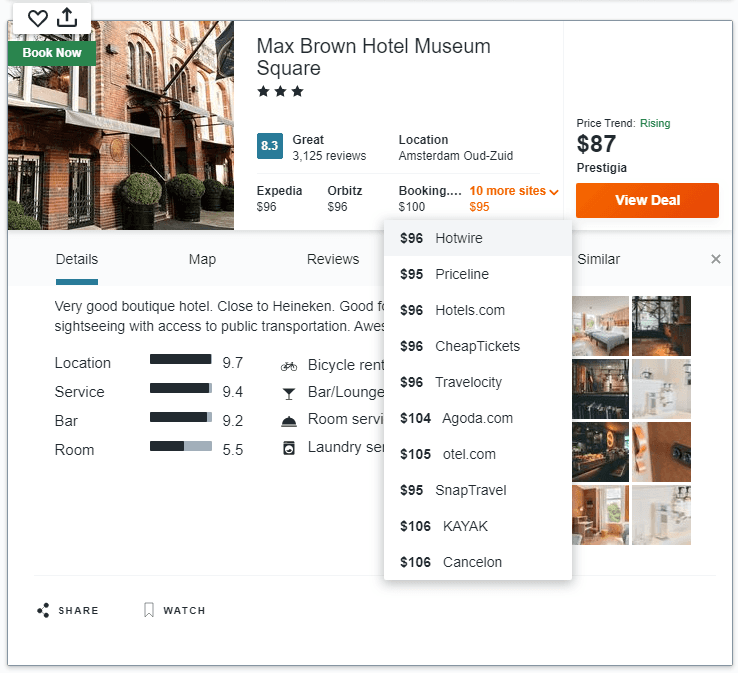
Prestigia, a small OTA with about 200 thousand monthly visitors, wins on Kayak with this hotel deal as it targets boutique accommodation
Consider the core value of each engine. Each of the major metasearch engines has its own advantage. Users all around the world appreciate Google for speed, simplicity, and the fact that their flight metasearch widget appears on the search engine panel if you sell flights. Kayak is extremely valuable for its “price forecasting.” And the core value of Skyscanner, in addition to rapidly rising popularity, is greater coverage of European destinations.
Search engine
About 30 percent of travelers use Google and other search engines to find their deals. So, investing in this channel is also a viable strategy.
Blogging. By writing a good, competitive, and compelling copy, you are not only making your service visible to search robots. The extra value here is that you are attracting customers with an educational and engaging read. It encourages their informative decisions and improves your chances that they accept your offer. A great example is TripMyDream, a small Ukrainian online travel agency. They’ve created a blog that eventually became the largest travel media in the country. The content includes articles on their best deals, the most popular destinations, local attractions, and the latest travel industry news.
Dedicated landing pages for target deals. There’s another common approach that many modern OTAs practice. You can create dedicated landing pages for your target deals and special offers. When writing copy for them, focus on specific keywords that people use to find these deals. This will allow search robots to find your pages and rank them higher. Besides the copy itself, you may add a booking interface to these pages, a price-picker calendar, product ratings, etc.
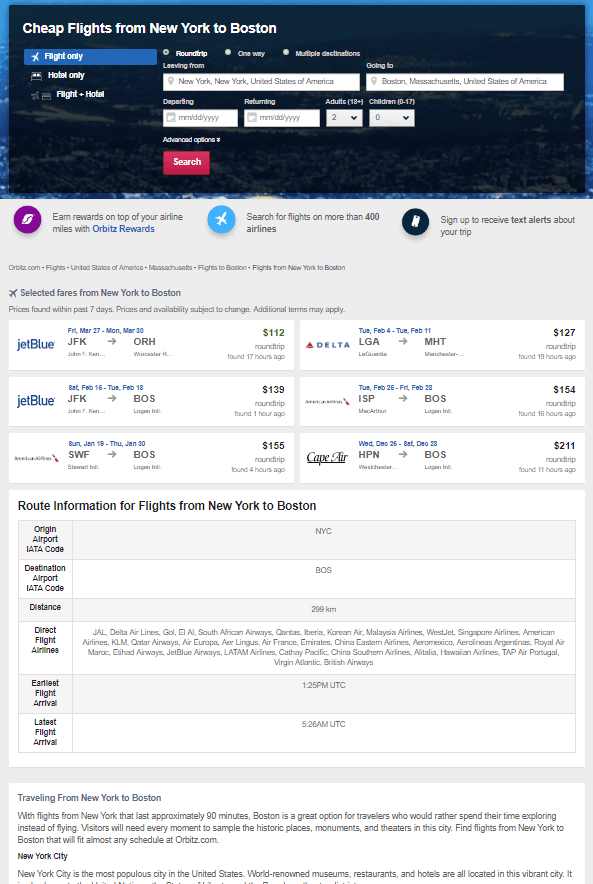
Orbitz has dedicated landing pages for hundreds of their deals and packs them with all useful information that a traveler may need: a booking widget, selected fares, basic information, and even short copy describing the trip
Check our case study on the technical side of generating such pages.
Invest in SEO. The technical side of search engine optimization activities can also bring much to the table. Basically, SEO activities consider two main things:
- Internal activities to meet technical standards of search engines. These usually include installing tools like Google Console and Google Analytics, working with meta tags, reviewing a website for the right page redirection, code errors, and others.
- External activities usually include working with keywords, texts in general, and acquiring backlinks from other websites.
It’s worth mentioning that no external activities may begin without finishing all internal ones.
Fundamentally speaking, the main goal of SEO activities is showing the search engine that you understand traveler problems and know how to solve them.
Email marketing
Being probably one of the oldest selling channels, email marketing still works. The travel industry is no exception. The main goal of email marketing is not only to attract but to raise a customer’s interest and retain existing travelers.
Collect email accounts. The first step is gathering user emails. The easiest and most basic approach is allowing travelers to sign up for additional services like price-drop alerts and valuable newsletters. Be aware of GDPR requirements.
Pick the right mailing tool. A perfect mailing agent provides emailing automation and customized segmentation (age, price expectations, departure airports, etc.). Also, it must allow for analyzing user behavior, such as opening rates, a number of clicks, or even bounce rate. Tools like MailChimp or ActiveCampaign would be a good start.
Track behavior and make customized offers. Trace user behavior to understand what travel products and price range your readers usually react to. This will help you better segment customers.
At the same time, you may also build your entire strategy on suggesting customized offers by email subscription only, as Moonfish does. The only thing a user has to do is subscribe to emails and pick their home airport. Moonfish will send you notifications on destinations available from there.
Hot deals and discounts. You can use discounts as one of the most powerful selling points, stressing urgency or time-restricted conditions.
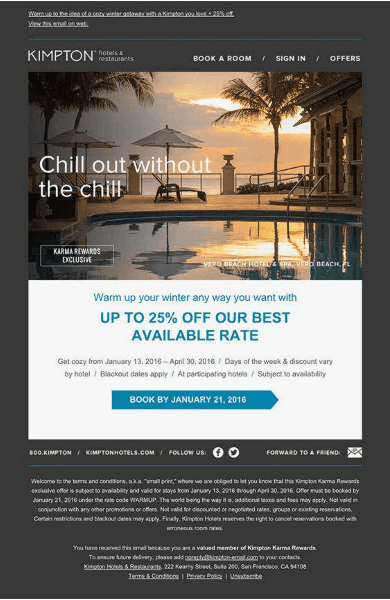
One of the great examples of submitting discounts was Kimpton Hotels and Restaurants. The discounts promoted the unpopular post-Christmas holiday season
You can offer generic hot deals but also consider customizing them to a customer’s preferences, such as destination or type of activities included. Or you may even suggest the coverage within the preferable direction.
Bundled options. To show care for a customer, you may also create so-called bundles – services and activities to extend and improve their experience. Say, your customer has booked a flight. In your follow-up email, you may suggest car rental services, an apartment, local restaurants, local attractions, and places to visit.
Holiday specials. Some people plan their trips on holidays. In your holiday-bound emails, you can step back from a behavior-based approach and include diversified offers, just like Kayak does.
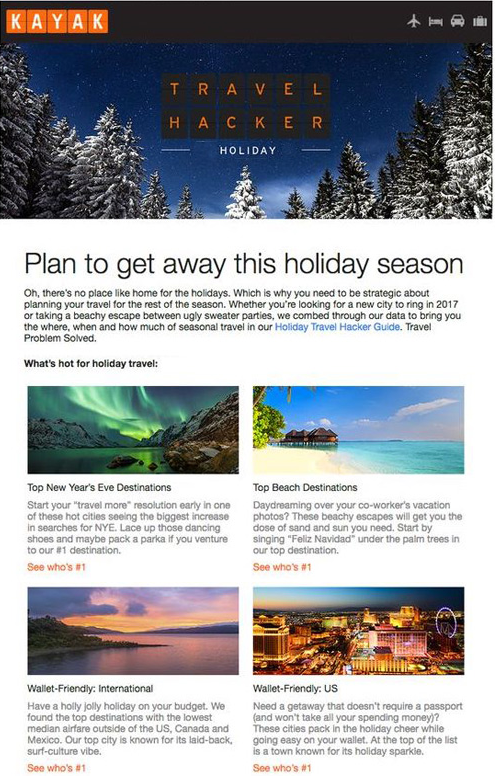
As you can see, there are both wallet-friendly and luxurious destinations and tour packages
You might also congratulate your customers on their birthday by suggesting special discounts or giveaways to show appreciation for using your services.
Web adverts
Web banners and links also still work. But things aren’t that simple. Even though adverts remain one of the most straightforward ways to attract the right audience, the way you do web advertising can be tricky in travel.
Google search ads. Yes, those top links on the search page. Google search adverts can be effective if you run them for very specific keywords that don’t compete with the major OTAs and metasearch engines. Since displaying those depends on a sophisticated bidding algorithm that considers multiple factors – including the price you’re ready to pay per click and the way Google thinks that your page is helpful and relevant – competing with major brands may be tough here. On the other hand, if you’re lucky enough to have a number of very specific segments and deals that aren’t advertised by large OTAs, Google ads are a great way to start.
An interesting example here comes not from an OTA but a hotel chain, Red Roof. They realized that competing with Kayak or other heavyweight players in Google is expensive. So instead, they capitalized on stranded passengers after flight disruptions and targeted keywords like “hotels near O’Hare Airport” with mobile search only. There were a number of other smart tricks like tracking flight cancelation data using flight APIs in real time and matching it with geo-targeting in their ad campaigns. Eventually, they got 266 percent growth in nonbrand mobile bookings.
Retargeting. Sometimes it happens that a user has visited your website, searched for some flights or tours, but didn’t book. With retargeting adverts, you can remind them to do so.
But here’s the trick. Given that travelers usually immerse in deep research, it’s likely that they checked your website just to browse. Some tech-savvy, online travel agencies and travel tech startups like bd4travel embark on data-science-based personalization of ads defining which of the visitors are likely to make a purchase to target ads at them. How does it work? Basically, you set up a visitor behavior tracker on a website, analyze their actions, and then choose which of them are worth retargeting. This will help you spend your retargeting budget efficiently, rather than showing your ads to everyone browsing. You may check our case study on machine-learning-driven personalization in an OTA or read a dedicated article that describes how personalization in travel works.
Adverts on social media. Social media isn’t much different in terms of the approach to adverts. You’re still looking at highly targeted campaigns. And the good thing is that Facebook and its own brand, Instagram, are famous for deep and granular tools for segmenting your target audience. On top of that, Facebook has a dedicated travel-focused toolset for their platforms and audience network with learning
Video blogging and other social media
Travel bloggers are becoming increasingly popular with the audience. Travel agencies also try to capture this opportunity with useful and entertaining social media and video blogging. So, here are some general directions that you may consider.
Document your social media strategy. Similar to blogging on your website, only a systematic approach to social media will work. So, plan out the platforms that you’re going to use and be prepared to post regularly. Having an editorial calendar is also a smart move.
Promote the place, not your service. At the end of the day, most people go to other countries to get new experiences. It’s not about staying in an apartment or by the pool. It’s about getting impressions that they have never had before. So instead of promoting hotels or airlines, tell more about destinations. Intimate and cozy cafeterias, locales to visit, and hidden gems of local attractions – not overcrowded with hundreds of tourists – will surely broaden the horizons for your customers.
Give life hacks. Many of your potential customers are looking for advice. So, you may create useful videos, both general and destination-focused. You may give some tips on packing or explain how to choose the cheapest flights and apartments in your target destinations, or maybe shoot a video or write a post explaining how transportation works in a particular city.
Invest in great imagery. A widespread opinion shared by travel agents is that posts with great images of the destination attract more attention and turn out to be more effective than posts without them. This is especially relevant for Twitter and Instagram.
Prepare to run customer service on social media. Most of the feedback, especially the negative variety, you’re going to receive on social media and review platforms like TripAdvisor. So, dedicate a customer service or PR specialist who will be instantly reacting to feedback and engaging in solving traveler problems. If you do look authentic and caring, it will become a powerful driver of traveler trust.
Final recommendations
Running a business in a constantly changing industry is an evolving process. Someday, techniques that worked before will have to be updated, so you’ll have to monitor where the travel sector is going. We hope this article gave you a few ideas on making it as a travel agency. Here are our final tips.
Know your segment and target it. The better you understand your travel segment in regard to destinations, customer groups, and deals, the more channels and hacks you can find to stay visible.
Constantly develop your partnerships. Your suppliers and exclusive deals that you have with them are your main assets. At some point, growing the number of partnerships equals the growth of your business.
Invest in custom technology. Although you’ll find hundreds of tools available for travel agents and online travel agencies, having your own unique angle for reaching travelers is proven effective by many cases, some of which we described in the article.
More on technological changes in OTAs here:
https://www.youtube.com/watch?v=94AaF1VmTsc
Implement-iterate. Marketing activities aren’t a single campaign. It’s an iterative and ongoing work. To survive, you have to constantly track your performance, monitor the market, and discover new distribution channels and opportunities.

Maryna is a passionate writer with a talent for simplifying complex topics for readers of all backgrounds. With 7 years of experience writing about travel technology, she is well-versed in the field. Outside of her professional writing, she enjoys reading, video games, and fashion.
Want to write an article for our blog? Read our requirements and guidelines to become a contributor.

